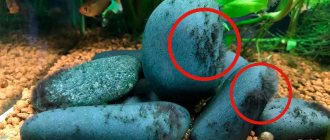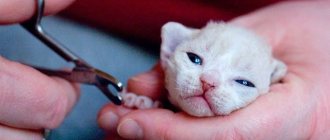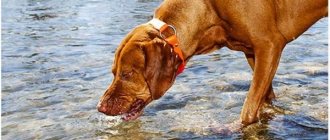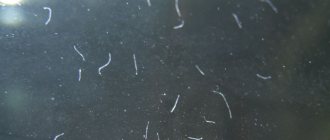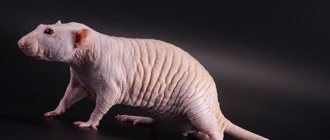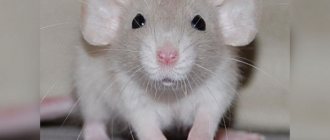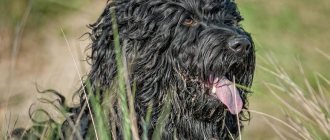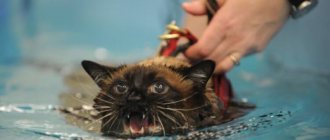How can a water rat harm you in your dacha?
To answer the question of how a water rat can harm your garden, first of all, you need to know what it eats.
The basis of the food supply of the voracious animal is made up of various semi-aquatic and floating plants (sedges, reeds, reeds, egg capsules, cattails, etc.), although on occasion it will not “disdain” insects, bird eggs, fish, frogs or small mollusks. The water vole eats leaves, stems, rhizomes and flowers; loves seeds, buds and bark of tree species.
In summer, animals generally have enough green food, but the problem is that water voles do not hibernate in the winter, so they are forced to make huge supplies of food or move closer to the cold weather to more comfortable food conditions - for example, to your garden or vegetable garden. .
In a day, a water vole can travel up to 2 km in search of food, and seasonal autumn migrations can reach 5 km. Do you remember if there are natural bodies of water at such a distance from your dacha?
In cultivated areas, the water rat immediately turns from a cute animal into a malicious pest. Here she, together with her “family,” arranges complex wintering burrows with supplies (from your plants!) for the winter and lives until spring. This vole will happily eat and store tubers, root crops and rhizomes of garden plants, and flower bulbs for future use; will eat the roots and stems of young fruit trees and shrubs (they love the bark of apple trees); fits perfectly into a grain or vegetable storage facility, if you have one on your site. A large colony of water voles can literally deprive you of your harvest!
How can you understand that this animal has come to your dacha and settled tightly there? During the warm period, in the feeding areas of the water rat, there remain open, trampled, crushed areas with the remains of gnawed plants, the so-called “feeding tables”. In the beds you can notice its underground passages and slides of discarded earth - “mole holes” (unlike mole structures, the ejections of earth above water rat burrows are all of different sizes and at different distances from each other). In cold weather, approaching garden plants, the animal digs long tunnels under the snow, and sometimes makes a nest right in the root system of fruit trees.
As a result of mass reproduction, in some years there are sharp outbreaks in the number of animals, and then in the fall “crowds” of water rats rush into fields and gardens, causing significant damage to agriculture.
In addition to such direct damage to garden and vegetable plants, a water rat can also harm the summer resident himself. The fact is that the animal is the main carrier of such a dangerous infectious disease as tularemia, as well as a number of other serious infectious diseases such as hemorrhagic fever, leptospirosis, etc.
What diseases do mice and rats carry? Mice and rats are carriers of diseases. This postulate is familiar to everyone. But what kind of dangerous diseases can be transmitted by gray rodents?
Lifestyle and diet
The favorite places for the water rat to live are river openings, areas near lakes, ponds and other bodies of water. For living they choose places with a humid climate.
Popular Ultrasonic rodent repeller clean house from rats and mice
Features of the water rat's habitat:
- in the north in the forest zone, where there are reservoirs and peat bogs;
- in the steppe in swamps and on the shores of lakes, around which sedge and reeds grow.
When cold weather sets in, the animal moves to forests, gardens and orchards, i.e. to where it is easier to get food for living. They spend the winter under a haystack, underground in deep burrows, which are usually built near water bodies. The length of the hole is about 3 m. Due to the fact that the holes do not freeze in winter, the water rat can move around in them calmly.
The water rat digs extensive burrow systems with nests and storage areas. This is where the animal spends most of its life, and where it is able to feed. Aquatic individuals build nests from reed parts. They place them in water or hang them among coastal plants. In burrows, the rat accumulates food reserves and does not fall into winter sleep.
Characteristics of water rats:
- animals are calm, lead a hidden lifestyle;
- in summer they spend most of their time in the water;
- in winter they do not hibernate, breaking through the snow and getting out of their holes;
- live in colonies, but live alone;
- during floods they move to higher places;
- operate around the clock;
- belong to very smart and cunning animals;
- have many enemies, but are able to quickly and easily escape from them;
- do not develop social structure;
- not aggressive in the absence of danger;
- treat people normally;
- If there is danger, they may bite.
The main food for a water rat is:
- plants;
- small vertebrates;
- small fish;
- underground parts of plants;
- larvae.
Among plant foods, the water rat prefers:
- reed;
- cane;
- sedge;
- arrowhead;
- algae and other aquatic plants;
- water lily roots;
- rhizomes and tree bark;
- young shoots of bushes;
- vegetables and fruits;
- plant seeds, spikelets of grain crops.
When summer comes, animals get their food near water bodies, as this is where they feel completely safe. At the same time, the exits from their burrows are placed near bodies of water so that they can hide in the burrow in case of danger.
In winter, the main diet of animals consists of tree bark, rhizomes of fruit trees and shrubs. On farms, the water rat is considered a pest, as it causes great damage to fruit trees. There is an active fight against them. Due to its unpretentiousness in food, the water rat is able to survive even in the conditions of Siberia and Yakutia.
A very important aspect of animal nutrition is safety when eating. To do this, they arrange for themselves something like a “feeding table” or a “basement-type feeding burrow” with the presence of various scraps in the form of leaves and stems.
Nutrition
River rats are omnivores. Near reservoirs they like to feast on reeds, sedges and reeds, and do not disdain other plants that grow near the water. They can eat grains, vegetables, fruits, gnaw the bark and roots of trees, and grass.
Rodents can also prey on small mice, insects, earthworms and even frogs. Rats feed in one place, which can be found by teeth marks on plants and dug up earth.
These animals are pests that can easily destroy crops in a garden or farm. A significant increase in the population to catastrophic proportions is observed approximately once every 8 years.
Then rodents, in search of food, begin to visit agricultural farms and destroy crops. Most of all, water voles like to feast on potatoes, beets and carrots.
In the fall, river rats begin to stock up, and therefore they drag everything edible into their burrow. At the same time, they choose only whole fruits and vegetables, as well as grains. All rot is left on the beds.
Why is the ground rat dangerous?
Since this harmful animal is highly fertile, it is not difficult to guess how much harm just one water vole colony can cause. A ground rat, if it settles in a country house or on a personal plot, is capable of eating everything that grows in the garden, as well as what is in a person’s home. If there is not enough food for them, then they begin to enter the house, feeding on cereals, bread crumbs, sausage, cheese, etc. In short, everything that a person eats, an earth rat will eat. In addition to the fact that it can eat part of the harvest, it spoils fruit trees and other green spaces, as it makes passages in the ground, violating the integrity of the root system. This leads to a partial loss of the harvest of fruits and berries, and often, after the active life of this animal, fruit trees and shrubs simply dry out.
In addition to cultivated plants, the earth rat spoils beds with vegetables and root crops, as well as flower beds, since the underground passages of the pest are located at a depth of no more than 20 cm. In Holland, this animal is considered the main enemy of tulip plantations. Under certain conditions, the ground rat can also destroy weeds. The process of harvesting grain crops is also becoming noticeably more complicated. Animals gnaw the bark from young trees of fruit and berry crops, which causes significant damage to garden plants.
In this regard, you should pay attention to the fact that if at least one individual is detected, you need to immediately consider tactics and strategies for combating such a pest. A pair of earth rats can quickly create their own colony, numbering dozens of living creatures, ready to swallow everything that gets in their way
Pest control: 3 options
At the first sign of pests appearing in your garden, you must immediately take all necessary measures to eliminate them. Otherwise, you will simply lose the entire harvest. There are several ways to remove rodents from your property.
Purchased funds
| Arsenic preparations ')); (w||(w=[]))&&w.push({id:b,block:'14502'});})(window,document,"mtzBlocks"); You can resort to one of the above methods.
This method will bear fruit in 10-15 days, it is after this time that the rat will die | |
Zinc phosphide or bleach
| |
Ultrasonic repellers
| |
| Arc trap This method can only be effective if there are only a few individuals in the area. The trap is installed in a small ditch (about 20 cm deep), which is dug near the rodent burrow |
Despite the effectiveness of these methods, they have a significant drawback. I would not recommend resorting to poisons, traps or traps if pets and small children can move freely around the area. After all, instead of rodents, they can become victims.
Traditional methods
Folk remedies (with some exceptions) are aimed not at destruction, but at scaring away rats from the area.
Rat Catcher Cats that love and know how to hunt can exterminate part of the rat population in a fairly short period of time. The remaining rodents will simply leave the area. Instead of cats, some breeds of dogs (for example, Jagdterrier, dachshund, fox terrier) can cope with the problem.
Cat litter If your cat is not a fan of hunting, you can use cat litter from his litter box to repel rodents. A litter soaked in cat urine (preferably wood) is buried in shallow holes throughout the area. While digging holes, rats will encounter the cat smell and decide that a predator has appeared in the area. Because of this, they may leave the plot
Scorched skin Roll up a rat carcass, rabbit skin (or other natural fur) and place it in a rat hole. Set the skin on fire. Due to the strong stench, rodents will either suffocate or escape from their homes.
Black elderberry To control pests, you can plant black elderberry in your area. The roots of the plant release cyanide into the soil, which is poisonous to rats. As a result, animals try to leave the area. You can also place elderberry leaves in burrows.
Spruce branches Water rats try not to step on something sharp with their paws
Therefore, it makes sense to place coniferous branches around fruit trees to protect their bark
Ash Scatter ash around your summer cottage (pay attention to rat trails). Ash sticks to the paws of rodents, which lick it off. Once ingested, the substance negatively affects the digestion of rodents.
Plants and hedges Getting rid of rats can be done by planting hedges and some odorous plants in the area
Suitable for these purposes: black currant; thuja; juniper; sweet clover; black root; Euphorbia ranks; grouse
Rat breeding
As such, there is no mating season in rats: the animals are able to reproduce all year round, but the peak of sexual activity occurs in spring and summer. Gray rats have the highest reproductive potential; black rats are somewhat inferior to them.
Each mature female rat mates with several males. Rat pregnancy lasts from 22 to 24 days, lactating individuals bear offspring for 34 days. Childbirth occurs in a nest lined with soft grass, paper and scraps of fabric. The number of cubs can be from 1 to 20. Rodents living in buildings are more fertile. At high population densities, several pregnant females occupy one nest and subsequently take care of the offspring together. The male rat does not take part in the fate of the children.
A rat carries its baby
Little rats are born naked, blind and helpless. Cannibalism is very pronounced among rats: the mother devours dead and non-viable cubs, and a careless father can destroy all the offspring.
But the remaining cubs are provided with careful care and attention: the female keeps the nest clean, constantly licks the pups and feeds them milk, which in rats is very nutritious and fatty (up to 9%).
After 14-17 days, the rat cubs open their eyes, and at the age of one month they are completely ready for independent life. Sexual maturity of young individuals occurs at 3-4 months, but rats begin to reproduce when they reach the age of six months.
Each female gray rat is capable of bearing offspring 5 to 8 times a year. Black rats do not breed in the cold season, so they breed 2-3 times a season. These days, the population of gray rats is growing steadily, and, according to experts, there are 2 rats for every person on the planet.
Reproduction
The breeding cycle begins in late February (if the winter is warm enough) or at warmer temperatures. The female is ready for reproduction already with a body weight of 60 grams. Pregnancy lasts about 20 days.
The degree of fertility of the water rat is high - in 7 months the female brings up to 6 litters. The total number of offspring from one pair of animals is up to 70 cubs.
One litter contains from 6 to 15 babies. The cub opens its eyes and begins to feed after 10 days. The animal's independent life begins at 1 month, when it leaves the hole.
The water vole becomes prey for most terrestrial and feathered predators (including snakes).
Physical difference between mouse and rat
Each of us has an idea of what representatives of the rat family, which includes both types of house rodents, look like from pictures and photographs. But with such information it is not always possible to really imagine the main difference between a mouse and a rat. There are several reliable signs by which every person can determine which rodent is in front of him.
- You can distinguish a mouse from an adult rat by the length of its body. In a mouse, the length of the entire body rarely exceeds 10 centimeters, while a rat can reach 30 cm in length. Naturally, there are also individual specimens of rodents whose sizes exceed the statistical average quite noticeably. The body of rats is denser and more muscular.
- Skull shape. In rats, the muzzle is always extended forward, due to which the elongated nose catches the eye. The mouse has a triangular, slightly flattened muzzle.
- You can also tell two rodents apart by their tail. Although its length is impressive in both large and small rodents, the general appearance has some differences. So the rat’s tail is quite powerful, thickened at the very base and almost bare. The mouse is endowed with a thin tail, most often it matches the color and presence of hair with the vegetation on the body.
- A significant difference is also observed in the weight of these two species of rodents. A small mouse has an average body weight of 40-50 grams. A rat can weigh up to 900 grams, especially females.
- You can distinguish rodents by their eyes and ears. A rat's eyes are small, while a mouse's are quite large and always look impressive on a small face. The mouse's ears are wide at the base, round and protruding to the sides. The rat is endowed with ears pressed to the muzzle, their base is small.
The adult rat differs from its younger relative in the structure of its fur. If you touch rodents, you will notice that the hair of a small mouse is soft and pleasant to the touch, while that of pasyuks is hard. Rats, thanks to their powerful paws and muscular body, can jump up to 80 cm in height, and in case of immediate danger, their jump can reach two meters. Mice cannot perform such acrobatic feats.
White rat
You can distinguish a large rodent from a small one even if you do not see it, but only assume the presence of a pest in the house
You can pay attention to the traces left; in a rat they are distinct and rare. Mice leave a chain of almost adjacent small tracks. You can also notice the difference between these two rodents by the fact that the house has been damaged more
Rats prefer to chew on wooden furniture or floors; mice most often damage packages; traces of their teeth can be seen on newspapers and books
You can also notice the difference between these two rodents by the fact that more damage has been done in the house. Rats prefer to chew on wooden furniture or floors; mice most often spoil packages; traces of their teeth can be seen on newspapers and books.
OUR READERS RECOMMEND!
To get rid of rodents, our readers recommend the Pest-Reject repeller
. The operation of the device is based on the technology of electromagnetic pulses and ultrasonic waves! Absolutely safe, environmentally friendly product for humans and pets. Read more here...
Danger to humans
Humanity has been waging its war against rodents for a very long time, and such a fight has even managed to receive a special name - deratization. However, in the east, rats symbolize wisdom and wealth, fertility and prosperity, so the image of rodents in such countries is purely positive. In the western territories, such representatives of the Mouse family are treated with disgust and some caution. To create an extremely negative image, it was enough for people to recall several plague epidemics associated with the carrier of the pathogen - the rat.
Also, some species of rats cause enormous damage to agricultural activities. Rodents often eat crops. As a result, many different methods of control have now been developed and continue to be developed, including repelling and destruction. Rats are currently one of the dangerous natural reservoirs of many anthropozoonotic and zoonotic infections.
Such rodents carry the pathogens of tularemia, plague, rabies, toxoplasmosis, typhoid, leptospirosis, as well as rickettsiosis, sodoku and many other diseases dangerous to humans and domestic animals. Unnoticed by people, representatives of the Mouse family are able to penetrate into the most hidden corners of a human home, using sewer and ventilation passages for this purpose.
It is generally accepted that it is simply impossible to destroy any rodents, including rats, one hundred percent. A quarter of a century ago, the main criteria for deratization were introduced, and the optimal permissible percentage of areas freed from rodents was also designated:
- 80% – the result is satisfactory;
- 90% – the result is good;
- 95% is a very good result.
Thus, the main goal of deratization is to establish and maintain quality indicators of an acceptable level of rodent numbers, at which there will be no complaints from people.
Nutrition
Dumbo rats, like all other rat breeds, are omnivores, which means they will eat anything and everything. It is best to start with grain mixtures. If your rat is a picky eater and likes to eat selectively, then look for grain mixtures where all the good stuff is mixed together. Follow the instructions on the package when deciding how much food to give your rat. It is also not recommended to use food made for other rodents. The food will not contain the nutrients your pet needs.
In addition to formula, you can supplement your rat's diet with fruits, vegetables, and plenty of protein. Rats need a high protein diet, and boiled eggs or boiled chicken are two treats they love. Carrots and apples are also favorite foods. Try not to give your rat too much fruit, as the sugar can be detrimental to their health in the long run.
Rats are not fed the following foods:
- chocolate;
- raw potatoes;
- bean curd;
- legumes;
- blue cheese;
- sausages;
- green banana;
- spinach.
With caution, rats are fed the following foods:
- beet;
- almond;
- turnip;
- pumpkin and sunflower seeds (no more than 15 pieces, as they contain fats that can lead to the development of diseases);
- radish;
- cucumber;
- cheese (no more than twice a week);
- sour cream (this is a fatty product, so the rat can be given no more than once a week);
- eggs (this is a delicacy for rats, which can be treated no more than once a week).
Rats also need plenty of water, so make sure their water bottles are kept topped up and the water inside is clean.
How to fight a rat
Underwater rats pose a danger not only to crops, they are also spreaders of dangerous infections
Therefore, having discovered a rodent on the site, it is very important to get rid of the uninvited guest as quickly as possible. Rodent control involves the use of various methods: Rodent control involves the use of various methods:
Rodent control involves the use of various methods:
- Ultrasonic repellers. You can control pests with. Its operating principle is based on the formation of high-frequency signals that affect the nervous system of animals. Because of this, rodents try to leave the territory they occupy as quickly as possible.
- Attracting biological enemies. An ordinary mongrel cat is quite capable of protecting an area from a vole. Its smell will repel rodents even before they appear on the site.
- The mechanical method of controlling rodents involves the use of various. However, this method is effective only with a small number of pests.
- Use of pesticides. Various baits are prepared from them, which are placed near rodent burrows.
Experienced gardeners claim that water rats are afraid of weeds. Animals try to avoid plants that have seeds with sticky thorns. An example would be burdock or. Animals are not able to remove spines from their fur, so they prefer not to live near such plants.
More precisely, the largest species of this family.
The animal has a size from 16.5 to 22 cm
(of which the tail is 6-13 cm) and body weight from 180 to 380 grams.
The body is massive
, with a large head and a blunt muzzle,
small almost invisible ears
. The tail is round, long, covered with fine hair.
In winter the coat is thick and long, in summer it is short and sparse. Rats that live in different habitats or are of different ages differ in the type of fur they have.
Back color: dark brown
, with various shades, the belly is dirty white.
Sometimes there are completely black
animals.
The toes on the front paws are short, ending in long, slightly curved claws. The hind legs are extended. Swims great
.
Vivid photos of the earth rat:
Small rat
The taxonomy of the rat does not end there; its continuation is the small rat. The Pacific or Polynesian rodent is found in the Philippines, New Zealand, as well as the countries of Asia and New Guinea. The habitat of the animal is forest and forest-steppe zones.
Depending on the distribution area, the length of the animal’s body varies. The animals inhabiting the mainland of the continent reach up to 15 cm, small rats living on the islands do not grow more than 11 cm. The weight of the animal is also small: only from 40 to 80 g. The fur of a small rodent on the back is brown, in the abdomen - light tones Its distinctive characteristics also include a pointed muzzle, large ears and short legs. The tail has a length commensurate with the size of the body, and is covered with scaly rings.
The diet of the small rat is very diverse, it includes: seeds, fruits and parts of plants, as well as insects, spiders, bird eggs and tiny chicks.
Small rats reproduce throughout the year; the reproduction process becomes especially active in the summer.
Decorative pets
Basic methods of struggle
To choose the most effective methods of pest control, you will need to understand each individual option.
It is important not to delay the process in order to preserve vegetables and other vegetation in the garden as much as possible.
Rat poison poisoning
Reading reviews from summer residents, you can understand that using poison is the most effective method for eliminating pests. The effect of the poison is massive and effective, but simply scattering the poison will not be enough. Water rats are smart, they immediately understand that they are trying to be destroyed. To obtain the expected results, the poison is disguised in bait using bread crumbs and other food. The finished product should be placed near holes or beds. If desired, you can buy special baits that are more effective than bread or vegetables.
Important! The main disadvantage of using poisons is that a rat can die anywhere on the site, so there is a risk of soil contamination with cadaveric poison. As soon as a water rat appears in the garden, you need to deal with it immediately
It is recommended to use one of three poisons.
Difa-Neo
A special grain bait that needs to be placed in holes and rat passages. It is often made from wheat soaked in chemicals. Manufacturers often use ethylphenacine for this.
Sold in the form of a paraffin briquette, which is perfect for places with high humidity.
Ratron Giftweizen
A fast-acting drug made in the form of granules. It is recommended to buy and use to get rid of pests very quickly.
Traps or snares
You can get rid of water rats in your area using traps and traps. They help quickly remove pests from the area, but the results will be positive with a small population.
Attention! After pests get into a trap or trap, it is necessary to quickly remove the corpse from the area. If this is not possible, then it is better to choose another liquidation option.
Mechanical
The method of disposal using mechanical traps is effective. Options include:
- traps;
- mousetraps;
- traps made according to various designs.
Adhesive
A good option for catching rats, but there is a drawback - the summer resident needs to constantly monitor the traps, check, and if the pest is caught, remove it. For the fight, such a measure turns out to be ineffective. Rats can get out of the sticky mass without much difficulty due to their size, which is larger than that of mice.
Electrical
Modern developments are also used in the production of pest traps. For these purposes, an electric valve is used, which can kill the animal with a discharge of current upon contact with the body of the pest. The method is effective, death occurs instantly, after discovering a corpse, you need to quickly remove it from the site.
Ultrasonic repellers
This option is humane, since under the influence of ultrasound the rats experience discomfort and begin to leave the area. The main disadvantage is that the process can be lengthy, because pests get used to the sounds. Well-thought-out repellers, whose sound range can be changed, help speed up the process.
Natural enemies
As soon as water rats appear in the garden, natural enemies come to the aid of the owners. The best cats are those that are able to eliminate animals very quickly. They love to hunt and in a few days they can destroy half of the entire livestock, the rest will go away on their own and will not return. However, not every cat is able to pick up the scent and kill a rat.
If the cat does not leave the apartment while spending time at the dacha, then you can use the contents of its tray. This option will be effective when filling the tray with wood filler on which the cat has urinated. It is recommended to bury the product shallowly in the ground. This will scare the rats, because they will think that a predator has appeared in the garden.
Rats are very sensitive to aromas, so improvised (folk) remedies have a positive effect if you want to get rid of them. Using simple methods, it is possible to influence the respiratory tract of rodents. So, there are both humane and aggressive means in which animals will suffocate or leave the area.
How to get rid of shrews
Before you decide to get rid of shrews, you need to weigh not only the disadvantages, but also the advantages of their presence in the areas. These animals are practically harmless because they feed on caterpillars, spiders, worms, woodlice, weevils and other insects that cause harm by staying in the garden. Plants are not included in their diet. The burrows these animals dig improve aeration. But shrews multiply quickly, their long underground tunnels interfere with the growth of some plants, and in their search for food they can damage the roots and root crops of plants.
If you decide to destroy pests, here are several methods:
- "Grandfather's";
- Rotten herring;
A foul odor will most likely help get rid of shrews. To do this, you just need to leave the scattered herring in the garden for a couple of days.
Digging the soil;
Deep digging about 70 cm down will have a strong effect.
Cat;
Well, everything is probably clear here.
Legumes, spurge, common marigolds;
If you plant these plants along the edges of the bed, then shrews are unlikely to settle there, since it is believed that they do not like them.
- Chemical;
- Poisonous gases or gas bombs;
If the tunnel is large, then the pests can simply escape.
Diesel oil or gasoline;
Animals are repelled by anything that has a strong smell.
Do not use this method on hot days, especially near trees or other objects that are easily flammable.
- Mechanical;
- Traps or traps;
You can use regular baited traps. Excessive noise scares away shrews, so tin pinwheels are also effective.
Electric repellers.
They are better than mechanical ones in that they can be turned on and off at will at any time. In addition, they have no effect on humans and domestic animals, but moles, snakes and mice will very quickly leave the territory in which the repeller is effective.
If all these methods are too “complicated” and laziness takes over, then you can simply fill the holes of these mice with water. But if there is not enough of it, then you can make it even worse by creating humid conditions that attract these animals.
Popular How to make a mousetrap: rating of the best models and tips on how to catch a mouse with your own hands (115 photos and videos)
Genus of water voles = Arvicola
- Read: Arvicola terrestris = Water vole
- Water vole or water rat
- Water vole - accounting methods
- Population cycle of the water vole Arvicola terrestris
There is only one species in the genus: the water vole - A. terrestris Linnaeus, 1758.
The sizes are average. Body length is 14-25 cm. The length of the tail is approximately half the length of the body. There are adaptations for both digging the earth and an amphibious lifestyle. The outer ears are small in size. The eyes are small. The internal outgrowths of the upper lips behind the incisors are of considerable size, densely covered with hair, but do not grow together and do not completely isolate the incisors from the oral cavity. The tail is covered with sparse, coarse and short hair. The tail is rounded in cross section. The first fingers on both limbs are not shortened. The third toe on the fore and hind limbs is longer than the fourth. Claws of moderate length. The soles of the paws are hairless, but have a ridge-like edge of hard and thick hair along the edges. The hairline is quite high, thick and soft with a sharp division into guard and down hairs. The color of the dorsal side of the body is one-color dark brown, sometimes almost black, the ventral side is dark yellow to gray. Seasonal color dimorphism is weakly expressed. Both males and females have specific lateral cutaneous glands. 4 pairs of nipples.
The zygomatic arches are widely spaced in the skull. The frontoparietal ridges are highly developed. The incisal openings are short. Bone auditory tympani are small in size, thin-walled, with poorly developed spongy bone tissue. The angular process of the lower jaw is small.
The cheek teeth have no roots and grow throughout the animal's life.
There are 36 chromosomes in the diploid set.
Distributed over a wide range: from the Atlantic coast of Europe east through the European part of the USSR and Siberia to Lake Baikal and the right bank of the Lena, south to the northern coast of the Mediterranean Sea, Asia Minor and Western Asia, the northern and southeastern parts of Kazakhstan, Northwestern China, Altai -Sayan mountainous country and the northern part of the Mongolian People's Republic, north to the bush tundra.
It lives in floodplains of rivers, in wetlands of various zones from the forest-tundra and southern parts of the tundra to the steppes inclusive. It rises into the mountains to subalpine meadows to an altitude of up to 2800 m above sea level. It also inhabits cultural landscapes - fields and vegetable gardens; They even settle in buildings. The seasonal change of habitats is sharply expressed, especially in the forest zone, where water voles migrate in winter from the banks of reservoirs to floodplain meadows or thickets of bushes. The shelter is provided by burrows that water voles dig, which are shallow and of simple structure. The nesting chamber is usually located at a depth of up to 1 m, and feeding passages are laid at a depth of 10-15 cm. The autumn and winter periods of life are characterized by active digging activity. In the warm season and during floods, underground or above-ground nests are made from grass and other plant materials. The breeding season is long. In mild winters it begins already in February and continues throughout the warm period of the year. During this time, the female brings 4-6 litters, each of which contains on average 6-8 cubs. The duration of pregnancy is about 40 days.
In different years, sharp changes in numbers have been noted. These fluctuations are especially pronounced for populations living in floodplains of rivers with changing flood regimes, as well as for lakes whose levels fluctuate greatly from year to year (for example, in Kazakhstan). During high floods, the number of water voles decreases sharply.
It feeds mainly on various plant objects, mostly aquatic and coastal: reeds, cattails, arrowheads, sedges, water lilies, and various meadow grasses. It also eats animal food: shellfish, insects, small fish. In winter, it feeds mainly on underground parts of plants, as well as on the bark and shoots of willows, poplars, and bird cherry.
Animals of some populations (in the north and east of their range) can make small reserves of food: reed rhizomes, potato tubers.
The fur of water voles is used as a secondary fur raw material.
Sometimes they seriously damage forest nurseries, orchards, and vegetable gardens, especially those located in river valleys.
Carriers of tularemia infection and leptospirosis diseases.
Water rat or, as it is also called, water vole
At first glance, this is a small, harmless animal - its weight is about two hundred grams, and its size reaches only 25 centimeters. The water rat has a small, blunt muzzle and a massive body. Voles are usually gray with a brown tint, but rarer black specimens are also found. The fur of these rodents is so dense and thick that it is quite difficult to see the body and ears behind it. Based on their name, these creatures live near bodies of water - streams, rivers, swamps - these are their main habitats. Water voles are excellent swimmers and excellent divers.
During high water, the vole prefers to move to nearby fields, orchards, and vegetable gardens, and, settling there, digs holes for itself, thereby causing enormous damage to these areas. Vole burrows are always very long, shallow, and have a complex structure.
The water rat feeds mainly on what grows near the reservoirs where it lives: reed shoots, reeds, sedges, cattails - all this is consumed by the rodent in very large quantities, as it has very low nutritional value. If a garden is chosen as the water rat’s habitat, then it feeds on almost everything that grows there - vegetables, herbs, fruit tree bark, berries, flower roots. All this is also eaten in large quantities. If a whole brood of voles has settled in the garden, they can destroy the entire crop.
In one season, a water rat can produce 3-4 broods, each brood can have from 5 to 7 cubs! As early as a month, vole cubs switch to the “adult diet” and join in the destruction of crops. And some of the cubs become capable of reproduction after 7–8 months. All these factors lead to a very rapid flooding of the garden with water voles.
The water rat is a very thrifty rodent - for the winter it makes quite good supplies for itself - you can often stumble upon a water vole’s “warehouse”. These warehouses deserve special attention: all the tubers in them are neatly stacked and they are all the same size and ideal shape.
So how can you protect your property from attacks by water voles?
Habitat
The vole is found throughout the world. Water rats live in forests, fields, steppes, and deserts. They prefer habitats closer to water. They know how to swim well, they like coolness, but not cold.
Many people are interested in where the water rat lives. Some representatives of humanity are trying to find fur-bearing animals in order to sew expensive products, while others are trying to destroy them.
Rat habitat
The waterfowl rat builds burrows in the ground. Builds numerous passages and underground passages. It breeds there, feeds its offspring, and overwinters. With the onset of unfavorable conditions - flooding, lack of food - they move to drier areas. Periodically returns to water.
On a note!
In most cases, underwater rats prefer to be found near swamps. Standing water freezes quickly with the onset of cold weather. By mid-autumn the animal begins to look for a more suitable habitat for wintering. Human lands are attracted by the loose soil, warmth, and abundance of food.
Meet the field mice
Most owners of summer cottages and private houses have had to deal with field mice on their property. These are small rodents whose body length does not exceed 12 cm and weight – 31 grams. The rather long tail is covered with sparse hairs and scales. The vole's fur on its body is soft and velvety, on its back it is reddish-brown, and on its belly it is whitish. A dark stripe runs along the back. The vole differs from the ordinary gray mouse in its smaller size, color and shorter tail. These rodents are distributed almost everywhere, except for the coldest northern regions. The animal moves quickly and silently. When danger is detected, it quickly runs away and hides; it is not easy to see the mouse. Moreover, during the daytime they usually rest in their burrows, and are active at night. They are smart, cautious and resourceful creatures. The appearance of rodents is usually detected by burrows and traces of their presence (damaged plants and household food supplies). A vole's teeth grow throughout its life, and the animal has to constantly grind them down. These mice eat roots, tubers and bulbs of plants, and seeds of various crops. In winter, they do not hibernate, but continue to actively feed, so they can gnaw the bark at the bottom of bushes and trees.
Voles reproduce quickly. They reach sexual maturity at two months of age. During the year, the female brings offspring 3-4 times, each of which contains from 4 to 8 pups. After two weeks, young mice are already able to live independently.
Voles can live up to 5-7 years, but they have a lot of natural enemies, so the average life expectancy is approximately 1.5 years. In summer they usually live outdoors. If there are human habitations or outbuildings nearby, then with the onset of cold weather these rodents tend to enter rooms where it is not only warm, but usually also has something to eat. It should be noted that mice show considerable intelligence and ingenuity to achieve these goals.
The most humane way to solve the “mouse” problem is to force the rodents to leave their burrows
Capabilities
The gray rat lives up to 3 years, but this is only if it is not sick, there is plenty of food, and there are no enemies. Usually such an idyll occurs only in laboratories or in home care. In nature, rats rarely live longer than one and a half years. Their abilities are unique. The fact that they anticipate earthquakes is not particularly surprising, because many animals can do this. But the fact that rats can predict where a shell will land is truly amazing. During the war, people, knowing about this talent of rodents, fled to those huts where the rats were hiding. A unique incident occurred in a market in France. It was moved to a new place, and already a day or two before, all the market rats had moved there, although, of course, no one informed them about this. Scientists have found that gray rats make about 5 thousand sounds, that is, they have their own “alphabet”.
These animals remember our faces and feel our character. They are able to pick up the slightest noise even in the 40 kHz range, which is used in electronic repellers. They distinguish two colors - blue and greenish. They dream, love classical music, and know how to laugh.
Reproduction and lifespan
Let's look at the different stages of a rat's life. Rat experts typically divide the life cycle of rats into 4 phases: newborn, 4 weeks, 1 year, and over 1 year.
Newborn rats are tiny, blind, and dependent on their mothers. They grow quickly, begin to crawl at 5 days, and their eyes open at 2 weeks.
After just 4 weeks, the young rat will no longer need its mother. They are fully alert and can feed themselves. But they will still need their siblings to be able to develop socially.
Around 6-8 weeks is the right time to bring home a baby Dumbo rat.
Rats reach full adulthood at 1 year of age. They are active, playful and easy to train. This age is ideal for breeding.
Pet rats over a year old may be less active and may develop health problems that are common in older pets.
Most rats live between 2-4 years, and with proper care, your Dumbo rat can easily live for four years. Most rats live long, healthy lives, but you should keep an eye on their health.
Description
The word “rat” makes some people cringe. If you look closely, both common and river rats are not so nasty. The latter are not particularly large comrades. They weigh about 250 grams. Their sizes vary from 20 to 25 centimeters.
They look like a pig and a guinea pig at the same time. A sort of strange hybrid: the snout of an underwater rat is short and rectangular, like that of a guinea pig, and the body of a rat is long, flexible, with a thin tail. By the way, the tail is covered with hairs and does not cause such disgust as a bald rat.
The water rat has long and thick fur. The upper part of the body (head, neck and back) is brown-gray. This is where the name came from - water rat. It seems that the color is ugly, but it is not. The photo shows that the animal is quite cute and its color scheme is in order.
The chest and belly of the animals are lighter than the main color.
Description of the species
The water rat is not a classic rat. The water vole is known to the general public under this name. In appearance, the rodent rather resembles a small muskrat or a growing nutria.
The body of the animal reaches 20 cm in length. The weight of the body fluctuates around 300 g. The entire body is covered with fluffy fur. The color can combine different shades of brown, gray and black. The modest ears are practically invisible from under the hair. But the tail is impressively long.
For a long time in Russia, water rat fur was used to make clothing and accessories. The animal was officially a commercial animal.
The tail appendix makes up a bold 2/3 of the carcass size. Round in cross-section, it looks dense, thick and strong. Short hairs are scattered throughout the area. It was for this part of the body that the vole began to be confused with a rat and was nicknamed accordingly.
Lifestyle
The species is distributed throughout the country, except for deserts, arctic zones and high mountain ranges.
The water rat chooses coastal areas to live. In spring and summer, it can most often be found near ponds, swamps, lakes, rivers, and large streams. The animal can also be found in nearby meadows and fields. This rodent prefers colonial life. The size of the "flock" can be completely different. At a minimum, this is a mother and cubs. There can be from 2 to 4 litters per season. Each includes 5-12 individuals.
The water vole is amazingly active. It is an excellent swimmer, able to dive deep, and copes equally well with climbing logs or leaning trees. Activities are equally successful during the day and at night at any time of the year.
Nests of one colony can be located at distances of several meters from each other. They are connected to each other by branched labyrinths underground. If the soil seems too wet to the rat or the time of flood has come, it will move into a hollow tree or make a house out of reeds on dry land.
The “huts” of such a vole can be distinguished from others by their spherical shape. During periods of decreased humidity, migration will occur in the opposite direction, closer to the water.
Description of appearance, distribution area
Water voles are sometimes called water rats or mice, but, strictly speaking, they have a very indirect relationship with these rodents, despite their external resemblance to them. These animals actually belong to the hamster family, although they bear little resemblance to the familiar domestic hamsters. Water voles look about the same as common voles, but they are noticeably larger. An adult can reach 15–25 cm, with the tail making up most of its length.
This animal has thick, fluffy dark gray fur from the beginning of its short muzzle to the base of its tail, which is covered with hair and has a small tassel at the end.
You can meet the vole almost throughout the entire territory of Eurasia - right up to Siberia and the North Caucasus. Most of all, she likes marshy areas and the banks of reservoirs, but fields, meadows and even vegetable gardens are also excellent for their life. These animals are very tenacious and prolific, so nothing threatens their spread.
However, the latter is hardly one of the good news - people associated with agriculture know voles firsthand and it is not in vain that they strive to exterminate them. These rodents spoil cereal crops and gnaw trees, causing significant damage. Voles do not attack people and when they meet, they will most likely try to hide.
If your summer cottage is located in a rural area, especially near rivers, lakes and swamps, prepare for the appearance of uninvited guests. Water voles, despite their name, live well in drier areas, including farms, vegetable warehouses, granaries, home gardens and vegetable gardens.
With the onset of cold weather, these rodents necessarily migrate from frozen bodies of water. Your site is perfect for voles' burrows, and your plantings are perfect for feeding them. The pest will happily eat your crop and ask for more. At the same time, it will also gnaw the stems and roots in your flower garden. Moreover, fruit trees will also be in danger: voles grow teeth very quickly, and in order to grind them down in a timely manner, they are forced to constantly gnaw on something hard.
This rather cute animal, which bears only a superficial resemblance to a rat, is in fact the largest species of field mouse. Its official name is water vole. In some areas it is known as the water rat or European rat.
The water vole has a round body covered with soft silky hair, a shortened muzzle with small ears and a long tail covered with sparse hairs and ending in a barely noticeable tassel (its length is half the length of the body).
In adult individuals living in different geographical areas, body sizes range from 14-26 cm, and its weight can range from 150 to 350 g (the weight of the largest animals sometimes reaches 500 g).
The color of the coat is very variable. Rodents living in different regions can be colored brown, gray and even black. The fur on the back is always darker, the sides and belly are lighter; representatives of some populations have a white stripe running down their backs.
Earth rats live in most of the non-chernozem zone of the Russian Federation, in Siberia (excluding the Far North), the Caucasus and Central Asia.
